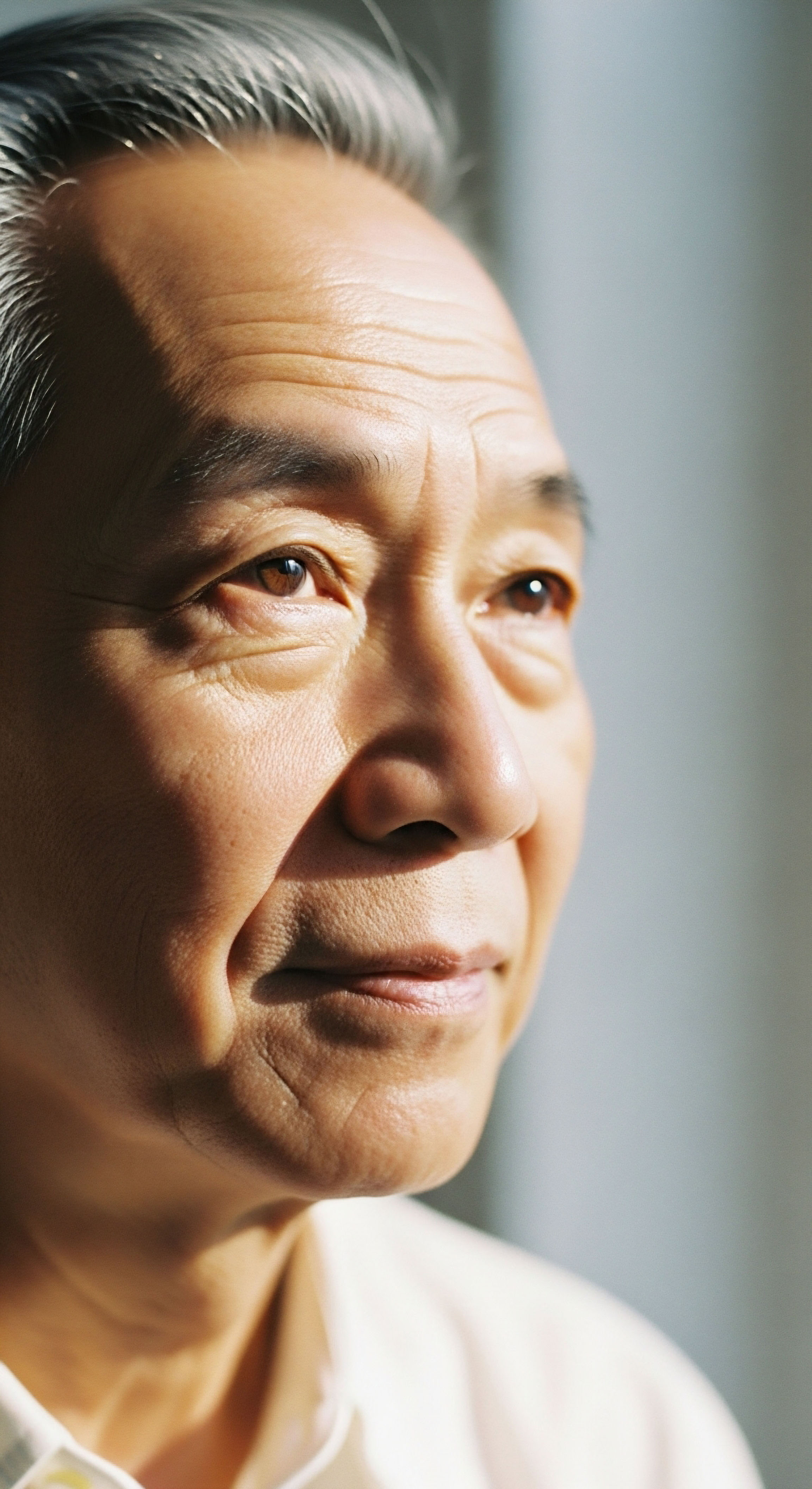

Fundamentals
You feel it before you can name it. A persistent fatigue that sleep does not touch, a subtle shift in your mood, or the sense that your body’s internal thermostat is miscalibrated. These experiences are valid, personal, and often the first signals that your internal communication network requires attention.
This network, the endocrine system, is the body’s elegant system of glands and hormones, a silent orchestra conducting everything from your energy levels to your response to stress. The question of whether lifestyle alone can recalibrate this intricate system when it has fallen into a state of clinical deficiency is a profound one. The answer begins with understanding the very architecture of your own physiology.
At the heart of your hormonal health lies a sophisticated chain of command known as the Hypothalamic-Pituitary-Gonadal (HPG) axis. Think of the hypothalamus in your brain as the mission commander, sending strategic signals to the pituitary gland, its trusted field general.
The pituitary then relays orders to the gonads ∞ the testes in men and ovaries in women ∞ which are the specialized factories responsible for producing the primary sex hormones like testosterone and estrogen. This axis operates on a sensitive feedback loop; the command centers in the brain constantly monitor hormone levels in the blood, adjusting their signals to maintain a precise balance.
When this system functions seamlessly, you experience vitality. When communication breaks down, the symptoms you feel are the direct result.
The endocrine system functions as a highly responsive network where lifestyle inputs directly influence hormonal output and balance.

The Four Pillars of Endocrine Support
Your daily choices are the primary inputs that regulate the HPG axis. These lifestyle factors are the foundational pillars supporting the entire endocrine structure. Viewing them as powerful modulators of your biology is the first step toward reclaiming control.

Nourishment as a Biological Resource
The foods you consume provide the raw materials for hormone production. Steroid hormones, including testosterone and estrogen, are synthesized from cholesterol. Micronutrients like zinc, magnesium, and vitamin D are essential cofactors in these biochemical assembly lines. A diet rich in nutrient-dense whole foods provides a steady supply of these building blocks, while a diet high in processed foods and sugar can introduce systemic inflammation, disrupting the sensitive signaling pathways of the endocrine system.

Movement as a Metabolic Catalyst
Physical activity, particularly resistance training and high-intensity interval training, acts as a powerful stimulus for hormonal adaptation. Exercise improves insulin sensitivity, which is deeply connected to gonadal function. It also helps manage body composition. By increasing lean muscle mass and reducing excess adipose tissue, you enhance your body’s metabolic efficiency and its ability to regulate hormones effectively. Regular movement communicates a message of capability and demand to your endocrine system.

Sleep as a System-Wide Reset
The majority of your body’s hormonal secretion, particularly of testosterone and growth hormone, is synchronized with your sleep-wake cycle. Deep, restorative sleep is the period during which the HPG axis undergoes critical maintenance and recalibration. Chronic sleep deprivation disrupts this rhythm, blunting the morning peak of testosterone and elevating stress hormones like cortisol, which directly interferes with the function of the HPG axis. Prioritizing sleep is a non-negotiable component of endocrine wellness.

Stress Modulation and the HPA Axis
Your body has a second, parallel command chain for managing stress ∞ the Hypothalamic-Pituitary-Adrenal (HPA) axis. This system governs your “fight or flight” response by releasing cortisol. In situations of chronic stress, the HPA axis becomes persistently activated.
Elevated cortisol levels send a powerful inhibitory signal to the HPG axis, effectively telling the body to deprioritize reproductive and metabolic functions in favor of survival. Learning to actively manage stress through techniques like meditation or deep breathing directly lowers the volume on these suppressive signals, allowing the HPG axis to function without interference.


Intermediate
Understanding that lifestyle choices are potent modulators of your endocrine system is foundational. The next step on this journey requires a more refined distinction, one that clarifies the specific circumstances under which lifestyle interventions can serve as the primary therapy versus when they must act as an essential support to clinical protocols.
The capacity of lifestyle adjustments to restore hormonal balance depends entirely on the nature of the deficiency itself. We must differentiate between a system that is functionally suppressed and one that is organically compromised.

Functional Deficiency versus Organic Deficiency
A functional hormonal deficiency arises from a system that is anatomically intact but is being actively suppressed by external factors. A common example is obesity-induced hypogonadism in men. Excess adipose (fat) tissue is metabolically active; it contains high levels of the enzyme aromatase, which converts testosterone into estrogen.
This process simultaneously lowers testosterone levels and raises estrogen levels, sending a feedback signal to the HPG axis to downregulate testosterone production further. The system’s hardware is undamaged, but its software is being corrupted by metabolic dysfunction. In this scenario, lifestyle interventions like significant weight loss and exercise can directly correct the root cause. By reducing adipose tissue, one lowers aromatase activity, reduces inflammation, and improves insulin sensitivity, allowing the HPG axis to restore its normal function.
An organic deficiency, conversely, occurs when a component of the HPG axis is damaged or absent. This includes primary hypogonadism, where the testes fail due to genetic conditions, injury, or medical treatments. It also includes menopause, where the ovaries cease their follicular activity and estrogen production plummets.
In these cases, the hormone-producing factories are permanently offline. No amount of diet or exercise can regenerate testicular Leydig cells or restart ovarian function. Here, lifestyle interventions are absolutely vital for managing symptoms and supporting overall health, but they cannot single-handedly restore hormone levels to a youthful, optimal range. This is the point where clinical protocols become necessary tools for biochemical recalibration.
Clinical protocols for hormonal optimization are designed to supplement the body’s own production when it is organically unable to meet physiological demands.

What Are the Available Clinical Protocols?
When a true organic deficiency is identified through symptomatic presentation and comprehensive lab work, targeted hormonal optimization protocols are employed. These are not a replacement for lifestyle; they are a sophisticated intervention designed to work in concert with a healthy foundation, restoring specific biochemical pathways that the body can no longer manage on its own.

Male Hormonal Optimization Protocols
For men with diagnosed clinical hypogonadism, the goal is to restore testosterone to an optimal physiological range while maintaining balance in other related hormonal systems. The protocol is often multifaceted:
- Testosterone Replacement Therapy (TRT) ∞ The cornerstone of treatment is typically weekly intramuscular or subcutaneous injections of Testosterone Cypionate. This provides a direct, stable supply of the primary androgen, alleviating symptoms like fatigue, low libido, and cognitive fog.
- Maintaining Testicular Function ∞ To prevent testicular atrophy and preserve fertility, which can occur with testosterone-only therapy, a signaling agent like Gonadorelin is often co-administered. Gonadorelin mimics the action of Gonadotropin-Releasing Hormone (GnRH), stimulating the pituitary to continue sending LH and FSH signals to the testes.
- Estrogen Management ∞ To control the conversion of the administered testosterone to estrogen, an aromatase inhibitor like Anastrozole may be used. This helps prevent side effects such as water retention and gynecomastia by maintaining a healthy testosterone-to-estrogen ratio.

Female Hormonal Balance Protocols
For women in perimenopause or post-menopause, the therapeutic approach addresses the decline in key hormones to manage a wide array of symptoms from hot flashes to bone density loss. Protocols are highly individualized:
- Testosterone Therapy for Women ∞ Often overlooked, low-dose Testosterone Cypionate administered via subcutaneous injection can be immensely beneficial for women, significantly improving libido, energy levels, mood, and cognitive function.
- Progesterone Support ∞ Progesterone is prescribed based on a woman’s menopausal status. For those with an intact uterus, it is essential for protecting the uterine lining when estrogen is administered. It also has calming, pro-sleep effects.
- Alternative Delivery Systems ∞ Long-acting testosterone pellets are another option, providing a steady release of hormones over several months. These may also be paired with an aromatase inhibitor like Anastrozole if clinically indicated.
These clinical interventions are precise tools. They are most effective and safest when applied to a system that is already supported by the robust pillars of proper nutrition, consistent movement, and managed stress. The lifestyle foundation makes the body more receptive to the therapy and mitigates potential side effects.
| Condition | Primary Goal of Lifestyle Intervention | Primary Goal of Clinical Protocol | Expected Outcome |
|---|---|---|---|
| Functional Hypogonadism (Obesity-Induced) | Reduce adipose tissue, decrease aromatase activity, improve insulin sensitivity. | May not be required if lifestyle changes are sufficient. Can be used short-term to kickstart progress. | Restoration of endogenous testosterone production toward an optimal range. |
| Organic Hypogonadism (Primary Testicular Failure) | Support metabolic health, manage inflammation, improve cardiovascular function. | Restore serum testosterone to a physiological level to alleviate symptoms and protect long-term health. | Symptom resolution and health protection via exogenous testosterone, supported by a healthy lifestyle. |


Academic
A sophisticated analysis of hormonal health requires moving beyond a simple list of inputs and outputs. It demands a systems-biology perspective, examining the intricate crosstalk between the body’s major neuroendocrine axes. The question of lifestyle’s role in restoring hormonal balance finds its most complete answer in the molecular interplay between the Hypothalamic-Pituitary-Gonadal (HPG) axis and the Hypothalamic-Pituitary-Adrenal (HPA) axis.
The chronic activation of the HPA axis, the body’s central stress response system, exerts a potent and scientifically validated suppressive effect on the HPG axis, providing a clear mechanism through which a lifestyle factor directly impacts reproductive and metabolic hormone production.

The Neuroendocrine Mechanism of Stress-Induced Gonadal Suppression
When the brain perceives a persistent stressor, be it psychological, emotional, or physical, the paraventricular nucleus of the hypothalamus releases corticotropin-releasing hormone (CRH). This initiates the HPA axis cascade, culminating in the adrenal cortex secreting cortisol.
From a teleological standpoint, this is a survival mechanism designed to divert the body’s energetic resources away from long-term projects like reproduction and metabolism and toward immediate survival. Cortisol achieves this diversion, in part, by directly inhibiting the HPG axis at multiple levels.
- At the Hypothalamus ∞ Elevated glucocorticoids, like cortisol, have been shown to directly suppress the pulsatile release of Gonadotropin-Releasing Hormone (GnRH) from the hypothalamus. This is the apical point of the HPG axis; reducing the primary signal effectively throttles the entire downstream production line.
- At the Pituitary ∞ Cortisol can also reduce the sensitivity of the pituitary gland to GnRH. This means that even if a GnRH signal is sent, the pituitary’s response ∞ the release of Luteinizing Hormone (LH) and Follicle-Stimulating Hormone (FSH) ∞ is blunted.
- At the Gonads ∞ Glucocorticoids may also exert a direct inhibitory effect on the steroidogenic cells within the testes and ovaries, impairing their ability to produce testosterone and estrogen in response to LH stimulation.
This cascade provides a powerful biochemical explanation for why chronic stress management is a primary, mechanistically sound intervention for improving hormonal health. By downregulating chronic HPA axis activation, one can release the suppressive brake on the HPG axis, allowing for a potential restoration of endogenous hormone production in cases of functional deficiency.
The interaction between the HPA and HPG axes provides a clear molecular pathway explaining how chronic stress directly suppresses reproductive and metabolic hormone function.

How Does Body Composition Alter Endocrine Signaling?
Another area of deep mechanistic importance is the role of adipose tissue as an active endocrine organ. In the context of functional hypogonadism, excess visceral fat contributes to hormonal imbalance through at least two primary pathways.
First is the upregulation of aromatase, an enzyme concentrated in adipose tissue that irreversibly converts androgens (like testosterone) into estrogens. In men with obesity, this creates a state of both low testosterone and high estrogen, a combination that strongly suppresses the HPG axis. Weight loss through lifestyle intervention directly reduces the total volume of aromatase-containing tissue, thereby decreasing this conversion and helping to rebalance the testosterone-to-estrogen ratio.
Second, hypertrophied adipocytes release a host of pro-inflammatory cytokines (e.g. TNF-α, IL-6). This state of chronic, low-grade inflammation further impairs the function of the HPG axis and can induce insulin resistance. Insulin resistance itself is linked to lower levels of sex hormone-binding globulin (SHBG), leading to changes in the bioavailability of circulating hormones. Exercise and improved nutrition are potent anti-inflammatory and insulin-sensitizing interventions, directly counteracting these negative pathways.

When Clinical Intervention Augments Physiology
In cases of organic deficiency, clinical protocols like TRT do not fight against the body’s physiology; they intelligently supplement it. A study published in The Journal of Clinical Endocrinology & Metabolism examined the effects of adding testosterone therapy to an intensive lifestyle intervention for older men with obesity and hypogonadism.
The research found that while lifestyle changes alone produced many benefits, the addition of testosterone specifically attenuated the loss of muscle mass and bone mineral density that can accompany weight loss. This demonstrates a synergistic relationship ∞ lifestyle improves the metabolic environment, while the clinical protocol provides the specific anabolic signal the body is no longer able to produce sufficiently on its own.
This integrated approach addresses both the systemic dysfunction and the specific molecular deficit, leading to a more complete therapeutic outcome.
| Intervention | Primary Molecular/Cellular Effect | Impact on HPG/HPA Axis |
|---|---|---|
| Resistance Training | Increases androgen receptor density in muscle tissue; improves insulin sensitivity. | Enhances tissue response to existing androgens; reduces inflammatory load on the axes. |
| Diet-Induced Weight Loss | Reduces total volume of adipocytes; decreases circulating inflammatory cytokines. | Lowers aromatase activity, leading to a more favorable T/E2 ratio; reduces systemic inflammation. |
| Stress Reduction (Meditation) | Downregulates amygdala activity and sympathetic nervous system tone. | Decreases chronic CRH/cortisol release, removing the inhibitory brake on the HPG axis. |
| Testosterone Cypionate (TRT) | Directly binds to and activates androgen receptors throughout the body. | Bypasses a compromised HPG axis to provide the necessary androgen signal for systemic function. |

References
- Corona, Giovanni, et al. “Treatment of functional hypogonadism besides pharmacological substitution.” Journal of Endocrinological Investigation, vol. 40, no. 8, 2017, pp. 789-805.
- Villareal, Dennis T. et al. “Testosterone Replacement Therapy Added to Intensive Lifestyle Intervention in Older Men With Obesity and Hypogonadism.” The Journal of Clinical Endocrinology & Metabolism, vol. 105, no. 12, 2020, pp. e4348 ∞ e4360.
- Kirby, E. W. et al. “Stress and the HPA Axis ∞ Balancing Homeostasis and Fertility.” Endocrinology, vol. 162, no. 8, 2021.
- Whirledge, Shannon, and John A. Cidlowski. “Stress and the Reproductive Axis.” Endocrinology and Metabolism Clinics of North America, vol. 39, no. 1, 2010, pp. 45-61.
- Gallo-Payet, Nicole, et al. “Stress, hypothalamic-pituitary-adrenal axis, hypothalamic-pituitary-gonadal axis, and aggression.” Metabolic Brain Disease, vol. 39, no. 6, 2024, pp. 1613-1636.
- “Perimenopause ∞ How To Manage Symptoms And Improve Your Overall Health.” Henry Ford Health, 2 November 2021.
- “Menopause – Things you can do.” NHS, Accessed 25 July 2025.
- “Hypothalamic-Pituitary-Adrenal (HPA) Axis ∞ What It Is.” Cleveland Clinic, 12 April 2024.

Reflection

Charting Your Own Biological Map
You have now seen the elegant, interconnected systems that govern your vitality. You understand that the way you feel is a direct expression of your internal biochemistry, and that this biochemistry is in constant dialogue with your daily life. The knowledge that lifestyle can be a profoundly effective tool for recalibrating your hormonal health is empowering. It reframes your choices about food, movement, sleep, and stress as direct conversations with your own physiology.
This understanding also brings clarity to the role of clinical science. It positions advanced protocols not as a last resort, but as a precise and powerful means of support when your body’s own systems are organically compromised. The path forward is one of informed self-awareness.
What is your body communicating to you through its symptoms? What are the patterns in your own life that may be influencing your endocrine function? This knowledge is the starting point of a personal investigation, a journey to map your own unique biological terrain.
The ultimate goal is to move through life with a deep understanding of your own operating system, equipped with the tools to support it, and the wisdom to seek expert guidance when a system component requires clinical repair.



